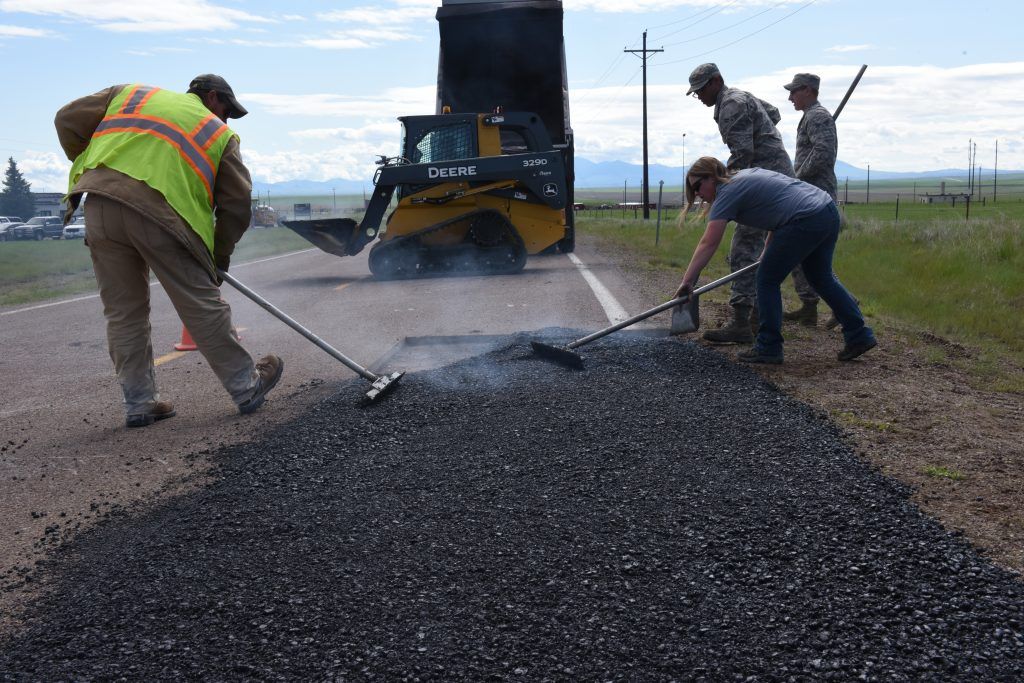Reimagine Your Room: Hot Mix Asphalt Paving for Angled Parking Lot Tasks
Reimagine Your Room: Hot Mix Asphalt Paving for Angled Parking Lot Tasks
Blog Article
Opening the Keys of Warm Mix Asphalt Modern Technology
Exploring the depths of hot mix asphalt technology uncovers a world where accurate formulations and precise processes converge to shape our roads and infrastructure. The fusion of fillers, accumulations, and binders isn't simply a building task but a strategic orchestration of resilience and efficiency. As we peer right into the complex dancing of parts, a tapestry of durability and sustainability unravels. What lies below this surface of asphaltic mastery, and what keys wait to be introduced in the realm of paving developments?
Relevance of Hot Mix Asphalt
Hot Mix Asphalt plays a crucial function in modern facilities growth due to its resilience and cost-effectiveness. As the most typically utilized leading product for roadways, highways, and vehicle parking whole lots, Warm Mix Asphalt supplies a range of benefits that add to its value in building jobs.
The durability of Warm Mix Asphalt stems from its structure, which consists of accumulations, binder, and filler materials that are meticulously chosen and mixed to fulfill particular performance demands. In general, the relevance of Hot Mix Asphalt in infrastructure advancement can not be understated, as it proceeds to be a cornerstone of modern-day building techniques.
Parts of Asphalt Mixes
The make-up of asphalt mixes includes thoroughly picked aggregates, binder, and filler products that are essential for attaining particular efficiency requirements. Accumulations are the key element of asphalt blends, providing stamina and security. These aggregates can be all-natural, such as crushed rock or crushed rock, or artificial, like recycled materials from old pavements. The binder, commonly bitumen or asphalt concrete, holds the accumulations together and supplies adaptability and sturdiness to the mix. The option of the binder is crucial as it directly affects the mix's efficiency in different climate condition. Fillers, such as hydrated lime or Portland concrete, are made use of to improve the mix's workability and aging resistance. Angled Parking.
The combination and proportion of these components play a considerable function in figuring out the top quality and efficiency of the asphalt mix. Designers carefully develop the mix to satisfy certain needs, taking into consideration factors like traffic volume, climate conditions, and sidewalk life-span. Proper choice and harmonizing of accumulations, binder, and fillers are essential for creating resilient, lasting asphalt sidewalks.
Combining and Manufacturing Methods

Once the aggregates are chosen, the binder, often asphalt concrete, is included to bind the products together. The binder's top quality and amount dramatically influence the mix's resistance, toughness, and adaptability to environmental elements. Additionally, fillers like hydrated lime or Rose city concrete may be integrated to enhance specific characteristics of the asphalt mix, such as its workability or dampness resistance.
Throughout manufacturing, the aggregates and binder are heated, typically in between 250-325 ° F(121-163 ° C ), to assist in mixing and guarantee proper layer of the accumulations. The mixing process has to be complete to accomplish a homogeneous combination that advertises the desired efficiency attributes of the asphalt. Different techniques, such as set mixing or drum blending, are utilized to achieve premium and consistent asphalt blends for construction tasks.
Elements Affecting Asphalt Efficiency
Factors affecting asphalt performance incorporate a series of variables that impact the more information longevity, durability, and overall top quality of asphalt sidewalks. One essential variable is the high quality of products made use of in the asphalt mix. The type and resource of aggregates, the binder top quality, and the additives all play a significant function in identifying the performance of the asphalt pavement. The rank of aggregates is crucial as it influences the mix's workability, stability, and resistance to rutting and fracturing.

Ecological conditions additionally affect asphalt performance. Temperature level variations, wetness infiltration, and web traffic lots can all affect the architectural integrity of the sidewalk. Layout considerations, such as sidewalk density and drain, are important in making certain the long-term performance of the asphalt sidewalk. By carefully thinking about these specialists, variables and engineers can maximize asphalt performance and enhance the service life of pavements.
Sustainable Practices in Asphalt Technology

WMA enables for the manufacturing and placement of asphalt blends at lower temperatures contrasted to typical hot-mix asphalt, resulting in decreased power consumption and greenhouse gas discharges. The usage of porous asphalt mixes can aid mitigate stormwater overflow concerns by allowing water to infiltrate via the pavement and into the ground, advertising all-natural water filtration and charge procedures.
Verdict
To conclude, warm mix asphalt modern technology plays a crucial role in modern facilities advancement because of its longevity and cost-effectiveness. By carefully balancing components, employing proper mixing techniques, and considering various factors, designers can develop high-quality asphalt blends that withstand rush hour lots and rough climate condition. Accepting view it sustainable techniques, such as making use of recycled products and warm-mix technologies, even more improves the ecological friendliness of asphalt technology.
Mixing and manufacturing methods in hot mix asphalt technology entail the specific combination and processing of aggregates, binder, and fillers to develop a high-performance and long lasting asphalt mix.Elements affecting asphalt efficiency encompass an check it out array of variables that affect the sturdiness, longevity, and total high quality of asphalt pavements. Lasting practices in asphalt modern technology include various campaigns aimed at lowering the ecological impact of asphalt manufacturing and paving processes. By including reclaimed asphalt sidewalk (RAP) and recycled asphalt shingles (RAS) right into new asphalt blends, the industry can dramatically decrease the intake of raw materials and power, while also lowering landfill waste.
WMA permits for the production and positioning of asphalt blends at lower temperature levels compared to standard hot-mix asphalt, resulting in reduced energy intake and greenhouse gas emissions.
Report this page